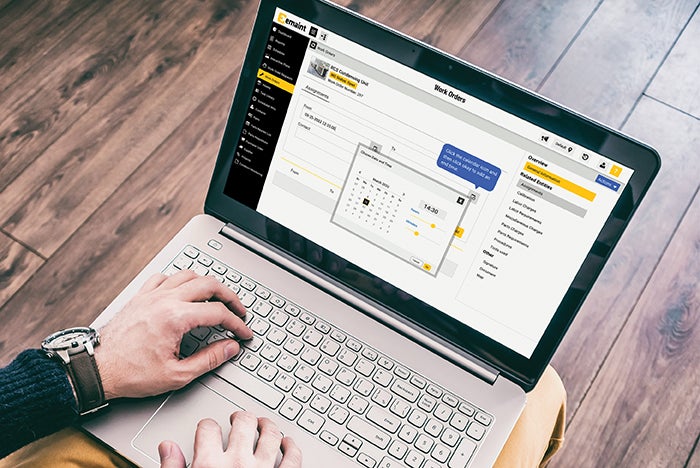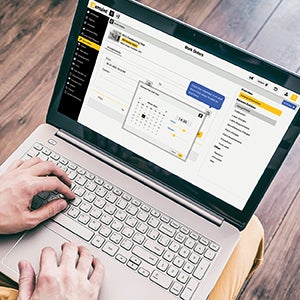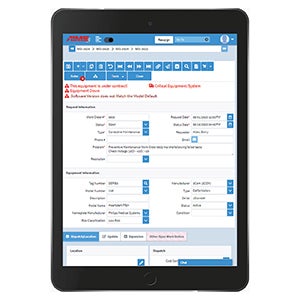CMMS software makers stress smart connectivity

Image courtesy of Fluke Reliability
Improvements in computerized maintenance management system (CMMS) software for hospitals and other health care facilities include deep data analysis, improved data security, and connections to artificial intelligence (AI) and the Internet of Things (IoT).
Additionally, the latest generation of CMMS software is represented by cloud-based solutions with benefits that include quick implementation, easy upgrades and data security. These systems incorporate mobile-based applications to reduce the need for documentation and provide technicians with real-time access to their work via instant notifications.
More hospitals also are utilizing CMMS software to facilitate preventive maintenance planning, history monitoring and workflow automation to improve the dependability and availability of critical equipment.
Better performance
CMMS software can now generate reports on equipment performance. “This information is being used to make data-driven decisions, enabling health care organizations to recognize trends, control costs, create plans and make decisions about equipment updates, replacements and the allocation of resources,” says Scott Nelson, vice president of marketing at TMA Systems, Tulsa, Okla.
Additionally, more hospitals are adopting mobile platform systems to facilitate access to data and to enhance the productivity of maintenance operations. “Implementation of sensor-driven technologies continues to expand in managing specific room environments and critical equipment for storage and management of patient food supplies and medications,” says Anupam Sachdev, CEO at zLink Inc., Maynard, Mass.
New CMMSs feature improved digital displays as well. For best results, external programs should be integrated with a CMMS, according to George Mills, director of technical operations for health care solutions at JLL Healthcare, Chicago. “This should include architectural and life safety drawings with equipment and other features tagged and integrated into the CMMS and displayed on the drawing. Intelligent inspection tools should be included in CMMS capability with equipment tracking displayed digitally.”
Historically, hospital maintenance mainly pursued risk-based approaches to maintenance and reliability strategies, according to Greg Perry, CMRP, CRL, senior capacity assurance consultant at eMaint by Fluke Reliability, Everett, Wash. “Today, we see more hospital facilities managers moving toward reliability-centered maintenance (RCM) and the benefits it can bring, which include less downtime, longer equipment life spans and fewer repairs.”
There is a major push toward integrating CMMS and compliance tool sets, which enables teams to better manage their day-to-day work order management needs and compliance tracking and reporting, says Josh Malbogat, vice president of health care sales at Brightly Software, Cary, N.C. “Features such as direct references to The Joint Commission, integrating environment of care rounding and specific compliance reporting dashboards are keys to a successful compliance strategy in a health care setting.”
Hospitals often have a large backlog of deferred maintenance and asset replacements — an unfunded liability that, for some systems, can reach into the billions of dollars, Malbogat says. “The driver now is to identify the highest risk areas and come up with replacement plans to mitigate that risk, while working within the confines of limited capital budgets,” he says. “The health care field needs solutions that identify the backlog and deliver the insights needed to prioritize capital spending.”
zLink Inc. offers the zLinkFM platform, which comprises 30 software components that meet a broad range of hospital requirements. The company has introduced an inventory management system that supports work order and preventive maintenance functions and better manages inventory thresholds. “The system supports all hospital consumables that can be ordered by departments from the internal warehouse using visualized product catalogs and intuitive checkout capabilities,” Sachdev says. “Another addition to the platform is the patient property inventory management system.”
Phoenix Data Systems Inc., Southfield, Mich., offers AIMS 3, the fifth generation of its CMMS product. The company strives to make the software so efficient that users can spend more time in the field, according to Aaron Peters, vice president of product development. “One of the most notable features is AIMS 3 automation. This tool allows the user to set up automatic processes that are triggered by specific events. Once a process is automated, the previous repetitive task will no longer require labor time.”
The CMMS offered by Smart Facility Software, Nashville, Tenn., is primarily focused on environmental services departments. The company recently added an HL-7 interface that allows users with ES Service Optimizer to receive discharge and transfer notices from the hospital’s admissions/discharge/transfer (ADT) system, and dispatch employees to clean the room. “Once the task is completed, we send a message to the ADT system informing it that the room has been cleaned,” says Mark Clabaugh, chief information officer.
TMA Systems has introduced an improved mass import tool that allows hospital administrators to use Excel templates to import and update new asset records. “They are able to validate key data fields in real time and make corrections prior to import,” Nelson says. “This ensures the accuracy of their asset inventory and allows administrators to manage their data without assistance from professional services or database administrators.”
TMA Systems also has released inspection findings as a way for hospital personnel to assess the condition of their spaces and equipment, and record their findings from a mobile device. All findings can be grouped within regulatory categories and can be converted into work orders, projects or capital planning audit items.
Brightly Software has introduced a metric-based compliance dashboard that provides insight into incomplete, complete and noncompliance work orders, as well as the key performance indicators driving compliance performance. This ensures that facilities managers can focus their attention on key areas of risk, according to Malbogat.
Brightly also has unveiled Origin, a strategic asset management and capital planning tool that provides real-time asset health updates so facilities managers know exactly where to focus their maintenance budget. By integrating capital planning with live work order and predictive maintenance data, Origin eliminates the need for repeat assessments.
EQ2 LLC, Charlotte, N.C., recently released HEMS One, a web-based application that works on Windows, Android and Apple iOS devices. HEMS One also has apps designed for mobile devices that work when not connected to the network, and then sync to the main system when connected again, according to Rich Sable, product manager. “The user can customize their view of output data and the fields for querying work orders and assets,” Sable says. “Fields recently added to HEMS One include campus, building and maintenance specialty.”
HEMS One includes a project management module and several optional third-party interfaces. “We have a floor plan management module to access drawing files from AutoCAD, Revit or other programs, which allows a user to easily locate an asset and its associated information,” Sable says. Also, EQ2 LLC offers an application called FastKey for lock and key management that can be used with HEMS One or as a stand-alone product.
FacilityONE, Charlotte, N.C., recently added two new modules to its CMMS software solution. The first, supply request, makes it easy for staff to communicate what, how many and where they need supplies or assistance. On a computer, tablet or smartphone, they can use a point-and-click webpage to send requests that are routed to a distribution point. This module replaces traditional processes, such as looking up codes or scrolling through drop-down menus.
The second module, capital planning, leverages a single source of truth to provide accurate projections of deferred maintenance costs and the need for future capital. “By adding capital planning data fields into the core application and presenting the results in an executive portal, this module delivers actionable data that makes it easier to prioritize planning decisions,” says Lynn O’Donnell, chief operating officer.
X5 is the latest version of eMaint by Fluke Reliability. “For hospital facilities managers looking to explore RCM strategies away from the fixed strategy of risk-based maintenance, this newest generation of eMaint offers many maintenance and reliability feature sets that enable such a strategy,” Perry says.
JLL Healthcare, Chicago, offers the Corrigo CMMS, which includes risk categories, asset and work order flow management, dispatching, invoicing and billing, and integration with its ATG compliance suite. Corrigo can facilitate work assignments through analytics and manage user spending for parts or repairs. JLL also offers ATG supporting modules to integrate with Corrigo, which allows users to fine-tune and manage their built environment. Included in the compliance suite are compliance manager, multidisciplinary rounding and life safety management.
Soleran Inc., Overland Park, Kan., has introduced the Soleran Healthcare platform, which utilizes consulting and software solutions to streamline compliance, processing and analytics. The health care-specific platform is comprised of six suites, which house 25 applications. It is cloud-based with no application program interface connections needed and offers real-time reporting and on-the-go entry, according to Amanda Haviland, director of program management.
Soleran also has introduced three hospital-related software applications: a compliance survey dashboard, a schedule planning report and a fire safety manager. The compliance survey dashboard can audit in real time, quickly recall reports, create a digital document review and attach reports directly to preventive maintenance data. The interactive nature of the schedule planning report allows managers to change assignments within the report and balance the workload among team members. “This tool can not only display the number of work orders but also the estimated time each will take,” Haviland says.
Smart and connected
Technologies such as AI, IoT and 5G are making CMMS solutions more intelligent, connected, proactive and efficient at managing hospital maintenance. These capabilities are evolving rapidly, according to Haviland, who notes the following trends:
- AI and machine learning are enabling more predictive maintenance capabilities. CMMSs can analyze sensor data from equipment to help forecast problems before they occur. AI can optimize scheduling and resource allocation, making maintenance processes more efficient.
- IoT devices can monitor equipment in real time, sending alerts for preventive maintenance. Also, IoT can integrate with CMMSs to automate work orders, track equipment performance and enhance asset management.
- 5G enables faster data transmission and sharing of data from IoT sensors, allowing for real-time analysis and remote monitoring of equipment.
Sable of EQ2 LLC predicts that as IoT technology progresses, it will be possible to send device or environmental information directly into the CMMS, replacing the need to make daily rounds. This will reduce workloads and increase the accuracy of measurements. “With AI, negative trends will be quickly identified, and the health care facilities management team will receive real-time alerts of these out-of-range measurements.”
Clabaugh of Smart Facility Software sees more CMMS automation on the horizon — with more instantaneous, efficient and detailed communications providing reduced turnaround and improved productivity. “Additionally, the advances will include predictive technology [which can sense future issues]. For example, hydraulic fluid temperatures rising above the norm in equipment could indicate low levels of fluid or high friction, which can cause problems.”

PROACTIVE SOLUTION
The latest version of eMaint is X5, which helps facilities managers shift from reactive to reliability-centered maintenance. Fluke Reliability

DEEP DIVE
WebTMA’s user interface makes it easy for hospitals to get a summary of work orders and drill down into the details with minimal clicks and navigation. TMA Systems

SUITE SOLUTION
This work orders suite includes four applications designed to provide compliance-centric solutions. Soleran Inc.

FAST RESPONSE
A “decision engine” takes in service requests and automatically assigns them to the correct environmental services team member. Smart Facility Software

SEARCHING SOLUTION
Facilities managers can better understand which equipment needs to be replaced by quickly adjusting filters. FacilityONE

SMART CHOICES
Corrigo is an intelligent CMMS that helps facilities managers make smart, data-driven decisions. JLL Healthcare

EASY ACCESS
The full scope of AIMS 3 functionality can be accessed from any device with an internet browser, enabling users to easily manage their workload. Phoenix Data Systems Inc.

PREVENTIVE PROCEDURES
HEMS One provides nested preventive maintenance tasks for managers to simplify procedure creation and ensure that necessary steps occur at the right scheduled intervals. EQ2 LLC

ALWAYS UPDATING
Origin strategic asset management and capital planning dashboard provides real-time asset health updates. Brightly Software
Neal Lorenzi is a Mundelein, Ill.-based contributor to Health Facilities Management.





